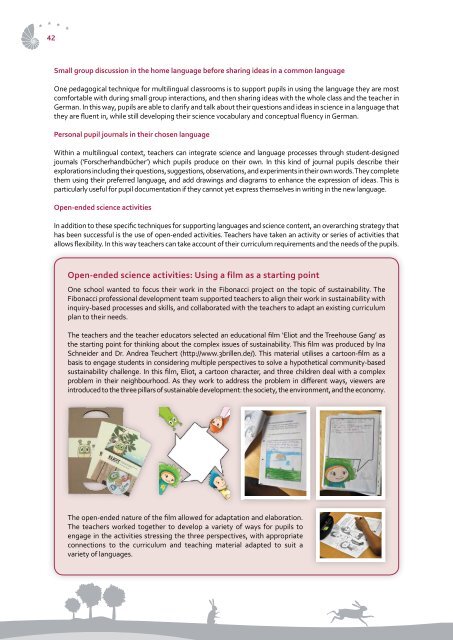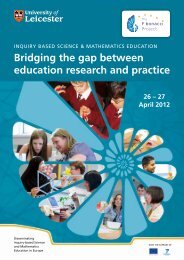Integrating Science Inquiry Across the Curriculum - Fibonacci-Project
Integrating Science Inquiry Across the Curriculum - Fibonacci-Project
Integrating Science Inquiry Across the Curriculum - Fibonacci-Project
Create successful ePaper yourself
Turn your PDF publications into a flip-book with our unique Google optimized e-Paper software.
42<br />
Small group discussion in <strong>the</strong> home language before sharing ideas in a common language<br />
One pedagogical technique for multilingual classrooms is to support pupils in using <strong>the</strong> language <strong>the</strong>y are most<br />
comfortable with during small group interactions, and <strong>the</strong>n sharing ideas with <strong>the</strong> whole class and <strong>the</strong> teacher in<br />
German. In this way, pupils are able to clarify and talk about <strong>the</strong>ir questions and ideas in science in a language that<br />
<strong>the</strong>y are fluent in, while still developing <strong>the</strong>ir science vocabulary and conceptual fluency in German.<br />
Personal pupil journals in <strong>the</strong>ir chosen language<br />
Within a multilingual context, teachers can integrate science and language processes through student-designed<br />
journals (‘Forscherhandbücher’) which pupils produce on <strong>the</strong>ir own. In this kind of journal pupils describe <strong>the</strong>ir<br />
explorations including <strong>the</strong>ir questions, suggestions, observations, and experiments in <strong>the</strong>ir own words. They complete<br />
<strong>the</strong>m using <strong>the</strong>ir preferred language, and add drawings and diagrams to enhance <strong>the</strong> expression of ideas. This is<br />
particularly useful for pupil documentation if <strong>the</strong>y cannot yet express <strong>the</strong>mselves in writing in <strong>the</strong> new language.<br />
Open-ended science activities<br />
In addition to <strong>the</strong>se specific techniques for supporting languages and science content, an overarching strategy that<br />
has been successful is <strong>the</strong> use of open-ended activities. Teachers have taken an activity or series of activities that<br />
allows flexibility. In this way teachers can take account of <strong>the</strong>ir curriculum requirements and <strong>the</strong> needs of <strong>the</strong> pupils.<br />
Open-ended science activities: Using a film as a starting point<br />
One school wanted to focus <strong>the</strong>ir work in <strong>the</strong> <strong>Fibonacci</strong> project on <strong>the</strong> topic of sustainability. The<br />
<strong>Fibonacci</strong> professional development team supported teachers to align <strong>the</strong>ir work in sustainability with<br />
inquiry-based processes and skills, and collaborated with <strong>the</strong> teachers to adapt an existing curriculum<br />
plan to <strong>the</strong>ir needs.<br />
The teachers and <strong>the</strong> teacher educators selected an educational film ‘Eliot and <strong>the</strong> Treehouse Gang’ as<br />
<strong>the</strong> starting point for thinking about <strong>the</strong> complex issues of sustainability. This film was produced by Ina<br />
Schneider and Dr. Andrea Teuchert (http://www.3brillen.de/). This material utilises a cartoon-film as a<br />
basis to engage students in considering multiple perspectives to solve a hypo<strong>the</strong>tical community-based<br />
sustainability challenge. In this film, Eliot, a cartoon character, and three children deal with a complex<br />
problem in <strong>the</strong>ir neighbourhood. As <strong>the</strong>y work to address <strong>the</strong> problem in different ways, viewers are<br />
introduced to <strong>the</strong> three pillars of sustainable development: <strong>the</strong> society, <strong>the</strong> environment, and <strong>the</strong> economy.<br />
The open-ended nature of <strong>the</strong> film allowed for adaptation and elaboration.<br />
The teachers worked toge<strong>the</strong>r to develop a variety of ways for pupils to<br />
engage in <strong>the</strong> activities stressing <strong>the</strong> three perspectives, with appropriate<br />
connections to <strong>the</strong> curriculum and teaching material adapted to suit a<br />
variety of languages.




